
Tuning an AMG CLK Black Series, eh? It’s not for the faint of heart or the thin of wallet, but you only needed to hear this City Performance-tuned version redline once to know that whatever money is tied up in the thing is absolutely well spent.
This CLK isn’t tweaked in any major way, but what mods have been carried out work well. And as it’s built for straight-line work, and regularly pumped down the quarter, that’s where we’ll start.
We’re talking 0-100km/h in the CLK Black taking just 3.96 seconds and a very handy 11.9 at almost 200km/h for the 400m dash. The remarkable thing is that it does this with just a cold-air intake, a custom exhaust and a tune of the ECU.
Oh, there’s also a clever piece of (simple) engineering called a Power Pulley. Figuring that the engine is going to see its share of high revs, the pulley on the end of the crankshaft that underdrives the power-steer pump, alternator and whatnot is replaced by a smaller one, effectively consuming less engine power to drive all those gubbins.
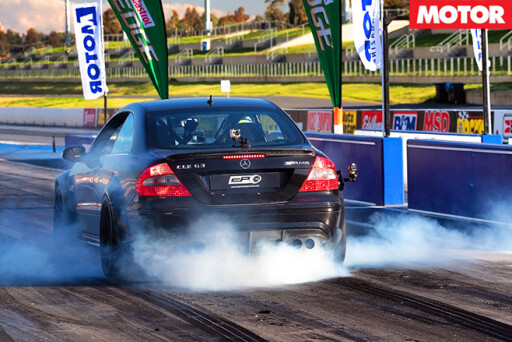 Those drag-strip numbers speak volumes for the basic Black Series package, but you knew that already, didn’t you? The CLK’s long suit might be its sprinting abilities, but when it comes to the roundy-round bits, it doesn’t come on quite so strong. Again, this is not what this car was built for, but it remains that its 2min17sec lap and 201km/h V-max at Eastern Creek aren’t indicative of its other attributes. At least in the wet.
Those drag-strip numbers speak volumes for the basic Black Series package, but you knew that already, didn’t you? The CLK’s long suit might be its sprinting abilities, but when it comes to the roundy-round bits, it doesn’t come on quite so strong. Again, this is not what this car was built for, but it remains that its 2min17sec lap and 201km/h V-max at Eastern Creek aren’t indicative of its other attributes. At least in the wet.
It isn’t for lack of hardware, though. Starting with the stiff two-door bodyshell, City Performance added H&R coil-overs, a top-shelf Brembo braking package and Michelin Pilot Sport Cups.The seats are the stock Black Series fare and the roll-cage is there for when it finally cracks a 10sec quarter and ANDRA demands monkey-bars.
The relative lack of trap speed at the circuit is down to the CLK not getting out of (or through) corners as fast as would be nice. In our fast-corner speed trap, it records 119.06km/h and in the slow corner it posts 48.07km/h, well down on its competition in the over-$150K category. All of this means its motorkhana time of 59.1sec, which is the slowest of the lot, is no real surprise.
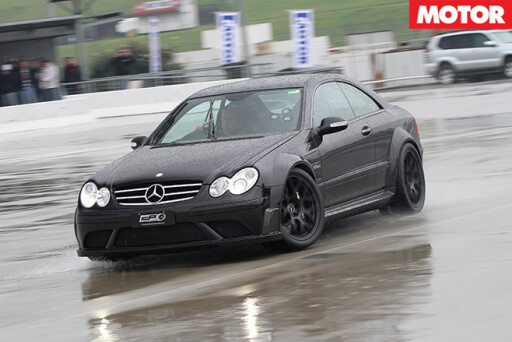 But the longer it’s out there, the longer we get to listen to that V8 yodelling. No complaints here.
But the longer it’s out there, the longer we get to listen to that V8 yodelling. No complaints here.
Were you to build a car specifically to crunch the Hot Tuner shootout, you probably wouldn’t build one like FRS’s GT3. And yet, such is the brilliance of the basic GT3 package (let alone the optional factory RS version here) that it’s quite capable of running with the best of them.
For starters, the dyno run is a big part of the shootout, but beyond its Evolve Technik tune and a better set of headers and cat-back pipes, it’s a stock GT3. So the 246.5kW number brings only a marginal gain over the factory set-up.Yet it’s faster than a stocker. Here’s why.
 The six-speed box is standard but there’s now a single-mass flywheel for improved engine response and lower reciprocating mass. The heavy-duty clutch also makes sense in a car like this, but the real key to it all lies in a change to the diff ratio which has been shortened to 4:1.
The six-speed box is standard but there’s now a single-mass flywheel for improved engine response and lower reciprocating mass. The heavy-duty clutch also makes sense in a car like this, but the real key to it all lies in a change to the diff ratio which has been shortened to 4:1.
Bilstein springs, 18-inch R-spec Dunlops and Pagid pads keep it all nice, but it’s the car’s balance that you keep coming back to. And that is shown up most clearly by the lap of The Creek. Against cars with much higher horsepower, the GT3 rattles off a 2:04.3 lap time – almost four seconds quicker than its stablemate, the GT2!
The Porsche GT3 is quicker than the GT2 in both fast and slow corners, too, and scores in the top three outright down the Eastern Creek chute, its 224km/h V-max is bettered only by blown V8s.
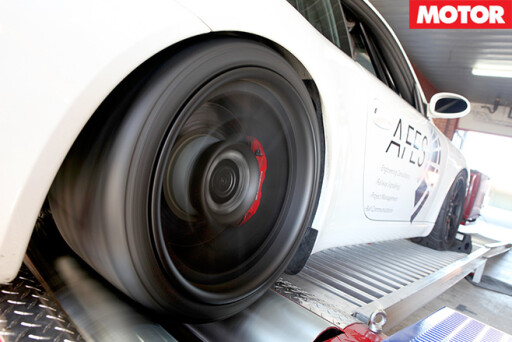 Meanwhile, the GT3 does give back some ground at the dragstrip. How much? Well, it launches to 100km/h in 4.25 (4.05 for the GT2) and crosses the 400m mark in 12.35 (11.72). The terminal speeds are vastly different, too; 205 for the turbo 911 compares with 190 for the GT3.
Meanwhile, the GT3 does give back some ground at the dragstrip. How much? Well, it launches to 100km/h in 4.25 (4.05 for the GT2) and crosses the 400m mark in 12.35 (11.72). The terminal speeds are vastly different, too; 205 for the turbo 911 compares with 190 for the GT3.
Across at the motorkhana, the same demons are exposed that plague pretty much anything else on the day with dry-weather hoops, a stiff set-up and two-wheel drive. Even so, 54.8 is a gutsy effort. And, if anything, this is the car that makes us curse the rain the most because in the dry, it might just be the one to beat.
One insanely fast factory hero car that has benefitted from forced induction this time around is the Evolve Technik-tuned BMW M3. And there are a lot of curious onlookers on hand once the Fitzy-fettled M coupe is strapped to the dyno.
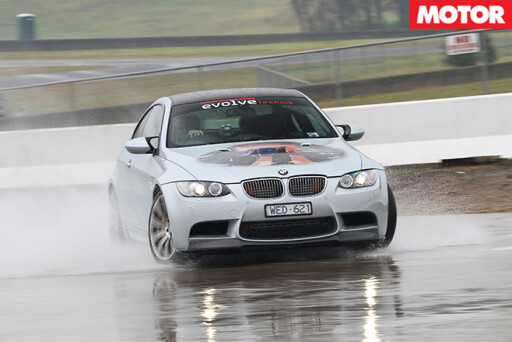 Where the stock M3 punches out 307kW at the flywheel, the Evolve car bashes out 305kW at the rubber. It’s also little surprise to find that it sprints from 0-100 in 4.7 and creams the quarter in 12.6sec at 190.62. On a different surface, we’ve actually seen this car run 12.4, so there’s no questioning its straight-line credentials.
Where the stock M3 punches out 307kW at the flywheel, the Evolve car bashes out 305kW at the rubber. It’s also little surprise to find that it sprints from 0-100 in 4.7 and creams the quarter in 12.6sec at 190.62. On a different surface, we’ve actually seen this car run 12.4, so there’s no questioning its straight-line credentials.
There’s more than 30-grand’s worth of G Power blower and plumbing under the lid of the BMW, and in Stage 2 trim (as it is here) the V8 is copping a 0.6-bar wallop. Making the most of that is a combination of an Evolve centre-section exhaust and a Milltek cat-back arrangement.
But looking at the spec sheet, there’s also been a lot of attention paid to the M3’s aero package, too.There’s a carbonfibre front spoiler with an extended lip and a matching rear diffuser.
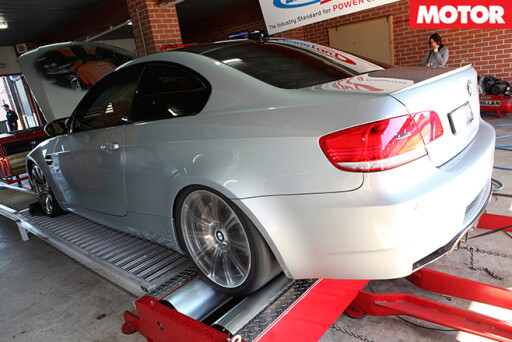 Throw in KW springs and dampers and a set of K-Mac sway bars and you have a car that is still super-streetable, but should be able to find its way around a circuit such as Eastern Creek.
Throw in KW springs and dampers and a set of K-Mac sway bars and you have a car that is still super-streetable, but should be able to find its way around a circuit such as Eastern Creek.
With a 2:05 lap, clearly the same problem of two-wheel drive and a soaked surface is hampering the M3 to an extent. But while its slow-corner apex speed is nothing special, maybe all that aero kit is doing its job at higher speeds, because its high-speed corner pace is right up there.
With loads of low-down supercharged grunt, throttle-by-wire and distinctly dry-weather oriented tyres (19-inch Pirelli P Zero Corsa) the M3 should, by rights, make a real meal of the motorkhana. But not so. And while 53.6 isn’t as quick as some of the daintier opposition, in this over-150K category where R-spec tyres are the norm and horsepower is measured in multiples of 100, the M3 is top of the tree.
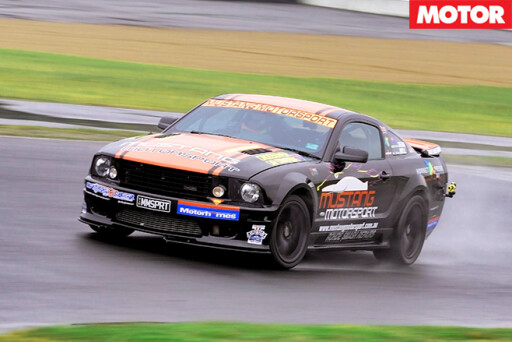 In braking terms, the M3 also makes a pretty big splash. With Brembo calipers (six-pot front, four-pot rear) and huge 380mm front platters, plus competition-friendly Pagid pads all round, the Evolve car’s 38-metre stopping performance is better than just good. Considering the all-up weight of the thing, it’s actually a brilliant showing and rounds out a car that could still be used as a day-to-day proposition.
In braking terms, the M3 also makes a pretty big splash. With Brembo calipers (six-pot front, four-pot rear) and huge 380mm front platters, plus competition-friendly Pagid pads all round, the Evolve car’s 38-metre stopping performance is better than just good. Considering the all-up weight of the thing, it’s actually a brilliant showing and rounds out a car that could still be used as a day-to-day proposition.
A quick skim of the Mustang Motorsport S302 Extreme will put a smile on the dial of any hard-boiled street machiner. Regardless of its current-model status, the Stang is a real old-school hottie.
Its five-litre lump is topped off with a twin-screw supercharger and blows 0.8bar down the V8’s gullet. There are flowed cylinder heads, forged slugs, titanium springs and retainers, a high-volume oil pump, deep Moroso sump, twin fuel pumps, a big radiator and low-restriction exhaust. Grandad would love it.
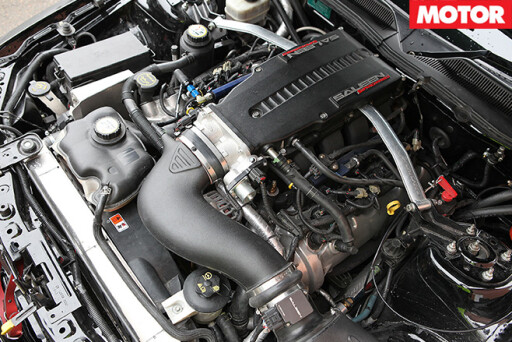 It goes about this in a high-tech kind of way, though, with a retuned ECU to make it all work in harmony. All up, the dyno spits out a huge 365.1kW, the second-highest number and one that’s only just pipped by the monstrous WP GTS.
It goes about this in a high-tech kind of way, though, with a retuned ECU to make it all work in harmony. All up, the dyno spits out a huge 365.1kW, the second-highest number and one that’s only just pipped by the monstrous WP GTS.
On the strip, the twin-plate clutch keeps things together, but even with big rear grip the Stang slithers its way up the track to record a 0-100 time of 4.45 and a 400m of 12.4 at 196.3km/h. As with the WP GTS, this comes back down to physics. No matter how much output you have underfoot, getting a heavy two-wheel-driven vehicle off the mark is often a hiding to nowhere.
With a rolling start, the Mustang would have been one of the faster cars on the day, but as it is, the first 60 feet kills its chances of a super-low number. Then, of course, it rains. And our pilots can’t get it around The Creek any quicker than a 2:12.0.
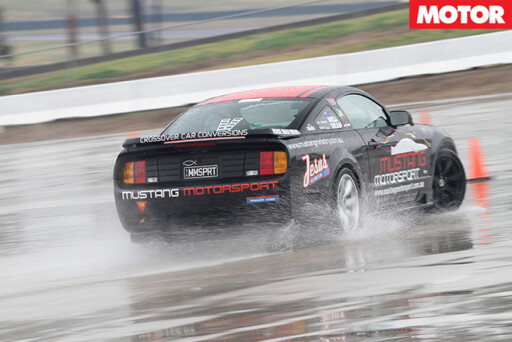 But that’s not the full story. See, while the Mustang lacks apex speed in the faster stuff, it is actually the quickest outright in the slower corners (call it a 55.89km/h apex), more than two full km/h faster than the next best, which happens to be all-wheel drive. The Stang is set up for tarmac rally events, and it shows.
But that’s not the full story. See, while the Mustang lacks apex speed in the faster stuff, it is actually the quickest outright in the slower corners (call it a 55.89km/h apex), more than two full km/h faster than the next best, which happens to be all-wheel drive. The Stang is set up for tarmac rally events, and it shows.
Still, this agility doesn’t translate to the motorkhana, where the Mustang get its shapely butt kicked around by the others. Then again slick, wet concrete and nearly 500 neddies at the treadies is never going to be a happy combo here.
You kind of have to wonder a bit about the bloke who wakes up one morning and says: “You know what? I reckon my GT2 is a bit underdone”. But that’s precisely where we are with the Fitzgerald Racing Services-tuned GT2.

The engine does hang together for the next two days (despite the MOTOR crew’s best scientific efforts) and that’s because we’re not talking about just wiring the wastegates closed to achieve the required boost pressure. Nope, this thing has “clever integrated” written all over it.
For a start, the stock snails are ditched in favour of a pair of modded VTG pumps with built-in dump valves. Then you bolt on a set of tuned-length headers and big-flow cats. Add an Evolve tune and, hey presto, it’s mega-muscle heaven.
 Even if the engine’s bottom end isn’t overtaxed by all this, there’s a fair chance the driveline might be, so a single-mass flywheel and a much meatier clutch are fitted. KW Clubsport suspension along with a strut brace are fitted and there are 19-inch aftermarket wheels shod with Pirelli P Zeros to round it out. And brakes? Oh yes, and the GT2’s 34.1m stop is nothing short of amazing.
Even if the engine’s bottom end isn’t overtaxed by all this, there’s a fair chance the driveline might be, so a single-mass flywheel and a much meatier clutch are fitted. KW Clubsport suspension along with a strut brace are fitted and there are 19-inch aftermarket wheels shod with Pirelli P Zeros to round it out. And brakes? Oh yes, and the GT2’s 34.1m stop is nothing short of amazing.
You wouldn’t think the dragstrip would be a rear-driven Porsche’s domain, but at this year’s event the GT2 owned the strip. Its 4.05 to 100km/h wasn’t the quickest, but it flashed over the 400m mark in 11.72 at 205.28km/h. That’s a fast enough time to nab outright honours.
Its 2.08:1 around The Creek isn’t indicative of its outright potential, but the same goes for everyone. Call it third-quickest among its $150K-plus rivals, some 3.8sec slower than its FRS-tuned GT3 stablemate. Neither was its slow or fast corner apex speeds indicative of what this car is ultimately capable of in the dry.
 The big surprise, though, is in the motorkhana, where it’s just pipped to the post by the blown M3, and it’s 0.4sec quicker than the GT3.
The big surprise, though, is in the motorkhana, where it’s just pipped to the post by the blown M3, and it’s 0.4sec quicker than the GT3.
And the GT2’s overall performance is pretty indicative of the whole Hot Tuner field. The rain hamstrung its forte events, and it shone in disciplines where it perhaps shouldn’t have.
But at the end of play, if you like a bet…

COMMENTS